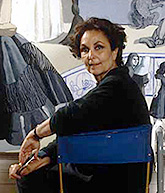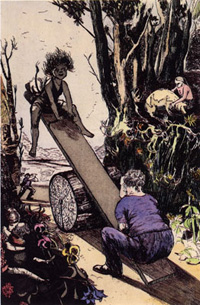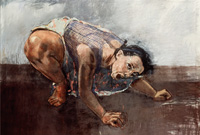With her Birthday on the 12th, May is a fitting month to point the spotlight on Paula Rego…
Paula Rego
 Born in Portugal in 1935, Paula Rego first started painting as a young child in Lisbon. As a teenager she came to England to attend school in Kent and then took up a place at the London Slade School. Much of her work has its roots in her childhood memories of Lisbon and Portugal. Her childhood observations and memories have always been important to Rego. Her imagination brings a dreamlike quality to her work conjuring chaotic imagery of sleep, fantasy and day dreams. Some Surrealist tendencies bring exposure of unconscious thought and uncomfortable impulsive human behaviours such as cruelty and humiliation.
Born in Portugal in 1935, Paula Rego first started painting as a young child in Lisbon. As a teenager she came to England to attend school in Kent and then took up a place at the London Slade School. Much of her work has its roots in her childhood memories of Lisbon and Portugal. Her childhood observations and memories have always been important to Rego. Her imagination brings a dreamlike quality to her work conjuring chaotic imagery of sleep, fantasy and day dreams. Some Surrealist tendencies bring exposure of unconscious thought and uncomfortable impulsive human behaviours such as cruelty and humiliation.
London and Portugal

Rego was the daughter of an electrical engineer and enjoyed a middle class home. She was cared for by her grandmother while her parents were posted to England by the Marconi Company. Meanwhile Rego attended an English speaking school in Portugal. In 1951 Rego travelled to England and attended finishing school in Sevenoaks, Kent. She then applied to the Chelsea School of Art but her London guardian believed her parents would be opposed to their daughter’s choice of further education. On returning to Portugal, Rego’s parents were supportive of her art studies so she decamped to the Slade School where she met her husband another art student. Time was spent between London and Portugal until the couple took up permanent residence in England.
Rego was part of “The London Group” with contemporaries Frank Auerbach and David Hockney. She exhibited at the ICA with this group and later had solo shows in Portugal although as a married woman she was not often exhibited in the UK.
Style

Rego’s art has constantly evolved from oil paintings through acrylic and collage. She admits to hating the smell of turpentine and oils. Her big love is drawing and what she refers to as pastel paintings. She is masterful at printmaking and sees this as an extension of her drawing. She is a prolific printmaker and painter although her early years saw her produce many collages. In early works such as “Always at your Excellency’s Service”, Rego was clearly Surrealist influenced, resulting in paintings almost bordering on abstraction although always retaining a strong element of narrative. In some ways she was following trends which veered toward abstraction in the circles of the times and she also used this technique to rebel against the classicism of the Slade.
Rego’s style changed dramatically when she was recognised and appointed to be “Associate Artist” at the National Gallery. She was briefed to work in whatever style she wanted around the collection. The collection of old masters seems to have drawn Rego into a tighter style of work featuring strong drawing with strong women as characters often in quite disturbing circumstances.
The nineties saw a use of pastels as a medium.

Her better known series of pictures at this time was the “Dog Women” series where women are depicted in the antithesis of natural female behaviour, instead behaving like dogs.
A style often used by Rego depicts staged dramas between lovers or families, that take you into the feelings of the protagonists inviting the viewer to empathise with the subjects. There are myriad interpretations for the meanings in Rego’s art, however she prefers the viewer to make up their own stories when facing a piece.

Four vital works of Rego’s were lost in a fire at the Momart warehouse in London. She owned three of the lost paintings while a fourth “Ambassador of Jesus” was owned by Charles Saatchi. Two pictures were from a series around the subject of opera and the other was the last one painted before her husband’s death.
Paula Rego lives in Hampstead, London, and has a studio in a mews at Kentish Town. The studio is a cross between a playroom and prop room at a theatre. She keeps forties and fifties clothes to dress her mannequins in, as well as toys. Here she constructs her works. She works in the studio on six days of the week, and makes sure she is home in time to watch her favourite soap opera EastEnders. She enjoys Sunday lunches with her three children who also model for her when needed.
In 2009 the museum ‘The House of Stories; Paula Rego‘ opened in Cascais, Portugal specifically to display the works of Paula Rego.
